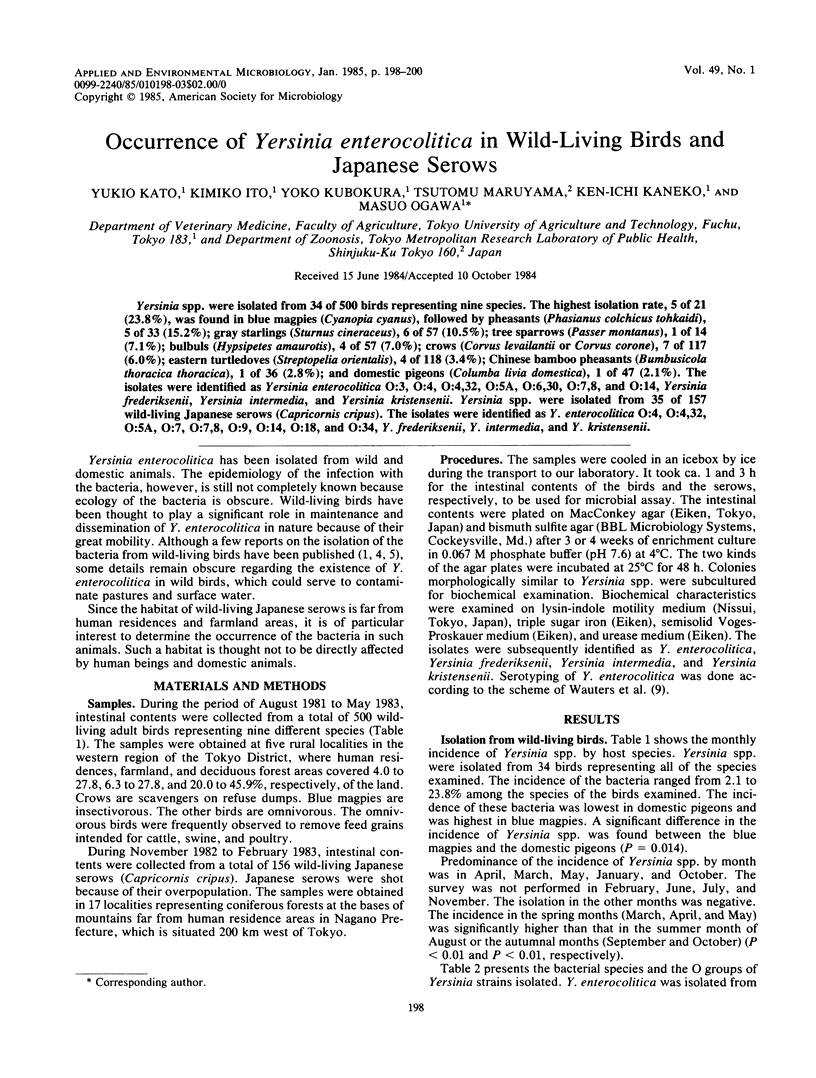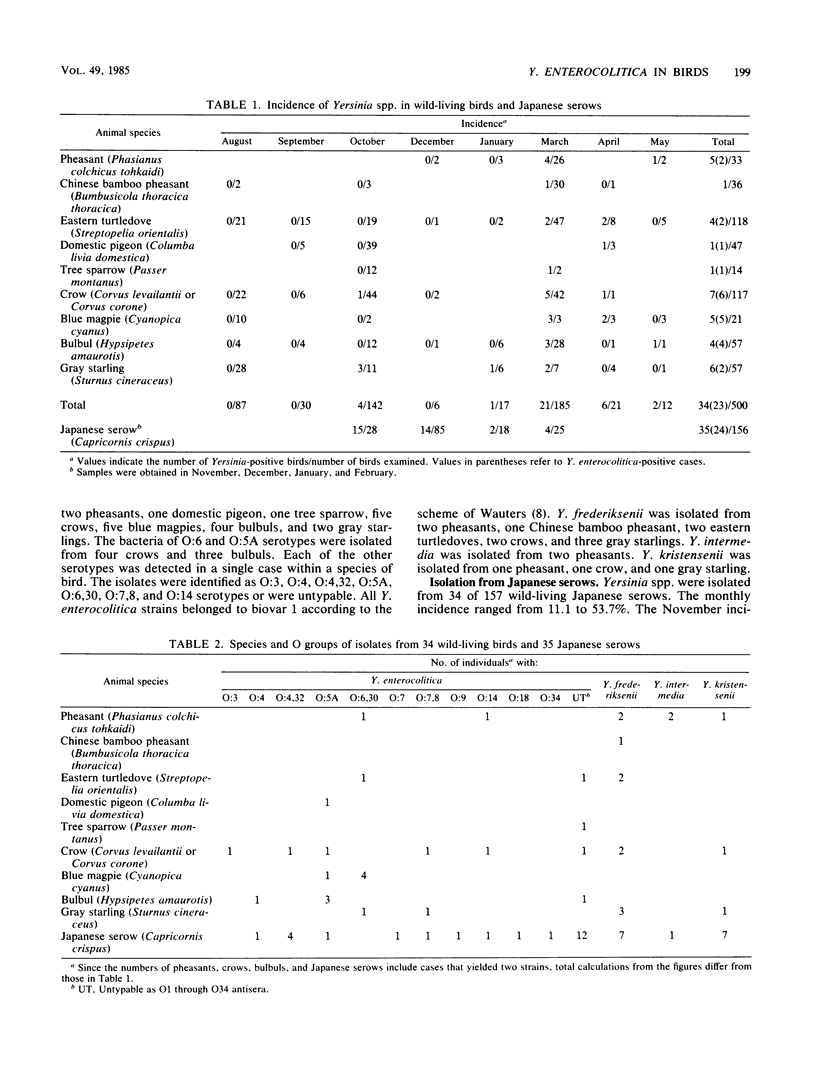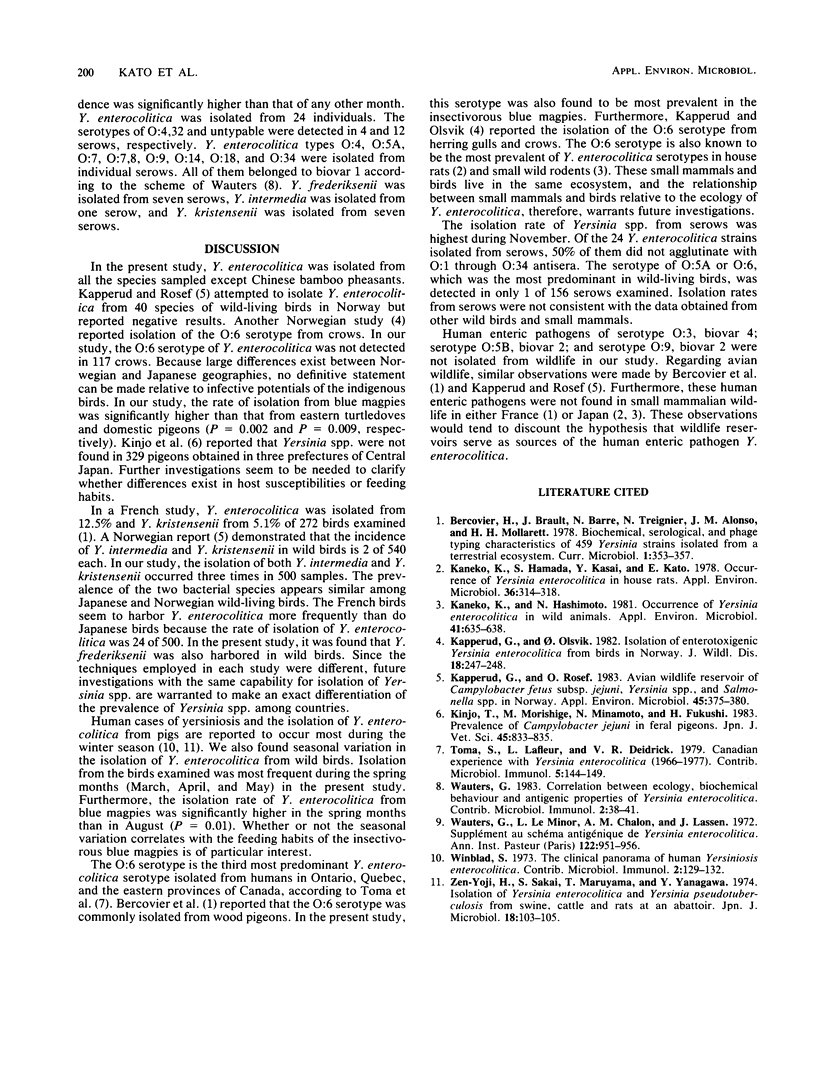Abstract
Yersinia spp. were isolated from 34 of 500 birds representing nine species. The highest isolation rate, 5 of 21 (23.8%), was found in blue magpies (Cyanopia cyanus), followed by pheasants (Phasianus colchicus tohkaidi), 5 of 33 (15.2%); gray starlings (Sturnus cineraceus), 6 of 57 (10.5%); tree sparrows (Passer montanus), 1 of 14 (7.1%); bulbuls (Hypsipetes amaurotis), 4 of 57 (7.0%); crows (Corvus levailantii or Corvus corone), 7 of 117 (6.0%); eastern turtledoves (Streptopelia orientalis), 4 of 118 (3.4%); Chinese bamboo pheasants (Bumbusicola thoracica thoracica), 1 of 36 (2.8%); and domestic pigeons (Columba livia domestica), 1 of 47 (2.1%). The isolates were identified as Yersinia enterocolitica O:3, O:4, O:4,32, O:5A, O:6,30, O:7,8, and O:14, Yersinia frederiksenii, Yersinia intermedia, and Yersinia kristensenii. Yersinia spp. were isolated from 35 of 157 wild-living Japanese serows (Capricornis cripus). The isolates were identified as Y. enterocolitica O:4, O:4,32, O:5A, O:7, O:7,8, O:9, O:14, O:18, and O:34, Y. frederiksenii, Y. intermedia, and Y. kristensenii.
Full text
PDF


Selected References
These references are in PubMed. This may not be the complete list of references from this article.
- Kaneko K. I., Hamada S., Kasai Y., Kato E. Occurrence of Yersinia enterocolitica in house rats. Appl Environ Microbiol. 1978 Aug;36(2):314–318. doi: 10.1128/aem.36.2.314-318.1978. [DOI] [PMC free article] [PubMed] [Google Scholar]
- Kaneko K., Hashimoto N. Occurrence of Yersinia enterocolitica in wild animals. Appl Environ Microbiol. 1981 Mar;41(3):635–638. doi: 10.1128/aem.41.3.635-638.1981. [DOI] [PMC free article] [PubMed] [Google Scholar]
- Kapperud G., Olsvik O. Isolation of enterotoxigenic Yersinia enterocolitica from birds in Norway. J Wildl Dis. 1982 Apr;18(2):247–248. doi: 10.7589/0090-3558-18.2.247. [DOI] [PubMed] [Google Scholar]
- Kapperud G., Rosef O. Avian wildlife reservoir of Campylobacter fetus subsp. jejuni, Yersinia spp., and Salmonella spp. in Norway. Appl Environ Microbiol. 1983 Feb;45(2):375–380. doi: 10.1128/aem.45.2.375-380.1983. [DOI] [PMC free article] [PubMed] [Google Scholar]
- Kinjo T., Morishige M., Minamoto N., Fukushi H. Prevalence of Campylobacter jejuni in feral pigeons. Nihon Juigaku Zasshi. 1983 Dec;45(6):833–835. doi: 10.1292/jvms1939.45.833. [DOI] [PubMed] [Google Scholar]
- Toma S., Lafleur L., Deidrick V. R. Canadian experience with Yersinia enterocolitica (1966--1977). Contrib Microbiol Immunol. 1979;5:144–149. [PubMed] [Google Scholar]
- Wauters G., Le Minor L., Chalon A. M., Lassen J. Supplément au schéma antigénique de "Yersinia enterocolitica". Ann Inst Pasteur (Paris) 1972 May;122(5):951–956. [PubMed] [Google Scholar]
- Zen-Yoji H., Sakai S., Maruyama T., Yanagawa Y. Isolation of Yersinia enterocolitica and Yersinia pseudotuberculosis from swine, cattle and rats at an abattoir. Jpn J Microbiol. 1974 Jan;18(1):103–105. doi: 10.1111/j.1348-0421.1974.tb00753.x. [DOI] [PubMed] [Google Scholar]


